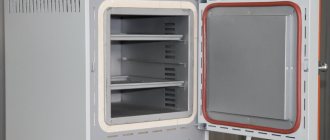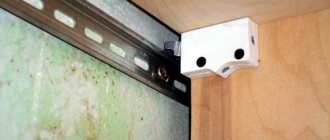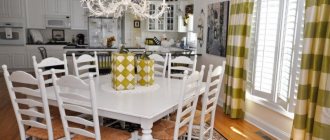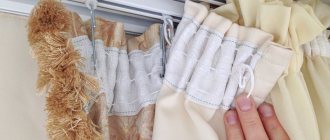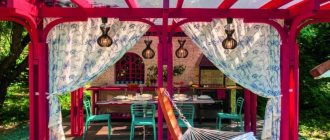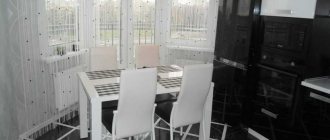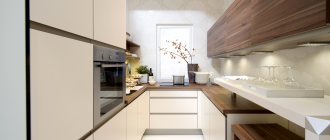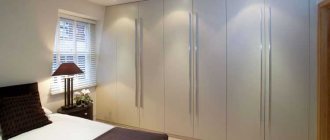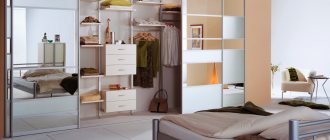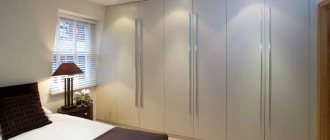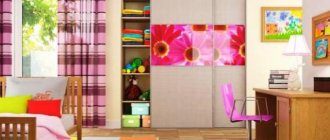Purpose
A fabric cabinet is intended for the same purposes as a regular one, made from standard materials: wood, chipboard, MDF, plastic. Its purpose is to store clothes, textiles, toys, shoes, office papers, books, magazines, small items for the home, dishes, seasonal items, and household supplies.
The purpose of such a piece of furniture is determined based on its “filling”. The presence of a crossbar with shelves means that the wardrobe is a wardrobe. Shelves and bright patterns make it a convenient storage area for toys in the nursery. A strict appearance, laconic compartments are an option for storing books or papers.
The main difference between a fabric closet and a regular one is that it is most often used as a mobile, temporary option. It is used in rented housing, with frequent moves, in the country, during renovations, in a student dormitory, in a children's room, where children will soon grow up and need completely different furniture. This fabric cabinet is easy to disassemble and transport from place to place.
A variety of colors, shapes and options allows you to organically fit a fabric wardrobe into almost any interior. But most people still prefer stationary cabinets for a permanent apartment. Therefore, the fabric option is primarily considered temporary.
How to assemble a cloth cabinet
Fabric cabinets can be easily assembled with your own hands, and no special tools are required during the assembly process.
In this article, we'll briefly describe the process and share assembly tips. It’s best to start assembling a fabric cabinet by studying the assembly instructions that came with it. It contains a diagram from which you can understand the principle of installing a fabric cabinet.
Warning: Use caution when assembling a fabric frame cabinet. Although there are no obvious dangerous parts, care must be taken to avoid accidentally cutting yourself with the edge of the tube.
Do not assemble furniture in a hurry, otherwise unpleasant incidents may occur.
Keep children away from closet parts!
Recommendation: It’s easier and faster to assemble a fabric wardrobe with two people.
After reading the instructions for assembling a fabric cabinet, the next step is to take all the parts out of the box and arrange them by type to make it easier to take the right part:
Then vertical tubes are inserted into the resulting base, and pre-assembled shelves for the future cabinet are placed on top of them.
This action must be repeated several times until all the shelves are installed.
This product is not available for delivery to your region
We always strive for the best to please our customers with the best prices.
Best regards, Wildberries online store.
Added to Waiting List
Reserve the product and receive it in the store within 1 hour
Reserve period: 4 days
Payment: in store, cash or card
The fabric wardrobe is easy to assemble and use, practical and very stylish, made from lightweight and durable combined materials, will be an excellent assistant in organizing your wardrobe, and will also decorate the existing interior in a profitable and original way. A durable and stable metal frame made of lightweight elements is covered with high-quality fabric material on top, which can always be easily removed for washing if necessary.
Information about technical characteristics, delivery set, country of manufacture and appearance of the product is for reference only and is based on the latest available information from the manufacturer
Advantages and disadvantages
A temporary or permanent fabric cabinet has many advantages over classic wood or slab furniture. Its main advantages:
- ease of assembly and disassembly - even a fragile girl or teenager can handle it without special tools and equipment;
- compactness, low weight when disassembled - easy to transport from place to place in a regular suitcase, it weighs several kilograms;
- a variety of colors, patterns, designs - thanks to this you can choose an option for any room;
- ease of care - the fabric cover can be washed in a regular machine without losing its appearance;
- convenience, versatility - textile cabinets are used to store a wide variety of things, and the presence of external pockets makes it even more practical;
- protection of things from light, moisture, dust - the cabinet is usually closed with a zipper or Velcro, and its fabric does not allow moisture to pass through;
- ease of movement - even when assembled it weighs little, one person can move it from place to place;
- low cost - compared to stationary ones, the fabric version costs mere pennies.
It also has disadvantages. For example, a textile cabinet will not fit into every interior; it will not be able to emphasize the status and wealth of the owners.
It is enough to periodically wipe off dust from an ordinary cabinet, and spills on it can be easily wiped off, but a fabric one will have to be washed. Usually covers have dust-repellent properties, but over time it still accumulates.
Folding fabric wardrobe - models, device, selection rules
Storing things in your own home over time requires updating your old closet. When constantly moving to rented apartments, it is difficult to transport bulky furniture with you. An alternative to heavy modules is a folding fabric cabinet. Functionally, it is no different from wooden or MDF wardrobes, but it has many other advantages.
Varieties
There are as many varieties of fabric wardrobes as there are for a regular one. The following varieties are popular:
- wardrobe - the most common option for a fabric wardrobe. It is represented either by a compartment with a crossbar for hangers, or the classic version - a department with a crossbar plus compartments with shelves for storing bed linen, towels, knitwear, bedding, underwear;
- cabinet rack - its contents are represented only by shelves. This variety can be adapted for various purposes: storing textiles, books, papers, kitchen utensils and other things;
- for a child’s room - can be used both for storing toys only and for children’s clothes, toys, and linen. Options for children's rooms have bright colors, convenient shelves, drawers, external pockets, drawings with favorite children's characters;
- for shoes - this is a convenient option for the hallway or for storing seasonal shoes. The material from which such storage facilities are made is impregnated with a special composition that repels water and dirt.
Clothes For children's For shoes
Rack
There are different types of cabinets according to the method of closing:
- with a zipper;
- Velcro;
- with ties;
- with curtains;
- completely open.
It’s a matter of taste, but the zippered option is the most airtight and reliably protects against the penetration of dust, dirt, and moisture. It will protect seasonal clothing and shoes well. Options with curtains or ties look cozy in the interior of a dacha or summer house, especially if you choose colors in the Provence style. It will be easier for children to manage cabinets with Velcro or completely open ones - especially when it comes to storing toys.
When purchasing a textile piece of furniture for a nursery, choose an option with good water and dirt-repellent impregnation. A good option would be a model with many decorative elements and bright details. The child will enjoy arranging things on his own, and additional elements will help develop fine motor skills and tactile abilities.
Open Velcro
With a zipper With curtains
Types of folding fabric cabinets - purpose
Types of fabric cabinets by type of purpose:
- wardrobe is the most popular option. With dimensions of 175 cm by 140 cm, the cabinet weighs only 6 kg. It captivates with its spaciousness and functional interior contents. The section with a bar will fit a lot of clothes on hangers. Towels and bed linen will take their place on small shelves or a spacious mezzanine. There will also be baskets with underwear and other small items;
- a shelving unit or bookcase is an excellent option for the living room. Placed near an armchair or sofa. Fill it to your liking: magazines, books or frames with photos, crafts, applications. You can also combine both options, creating a practical and decorative area. A fabric rack is also placed in the bathroom, filling the shelves with towels, replacement robes, and other bath accessories;
- For a children's room, cabinets of brighter colors, with drawings and images of fairy-tale characters are selected. External pockets and shelves with baskets will especially please your child. For comfortable wet cleaning in the nursery, it is recommended to choose a model with wheels;
- It is better to buy a folding shoe cabinet in bright or dark colors. Manufacturers claim that these models are distinguished by material impregnated with a special agent. Dirt and moisture are not absorbed into the fabric, fresh stains are easily removed. Despite this, for a long service life of the cabinet, it is recommended to place clean, dry shoes on the shelves. Models with 8 shelves are spacious, measuring about 140 cm in height and 60 cm in width. Moreover, the entire structure weighs only 3 kg.
Manufacturing materials
As the name of this piece of furniture suggests, the main material for its manufacture is fabric. Special synthetic materials are also used that have high strength, density and are impregnated with special compounds in order to keep moisture out and repel dust and dirt.
The fabric must also have certain properties:
- do not burn out in the sun;
- do not wrinkle when washing;
- do not shed;
- do not leave streaks or stains;
- be dense enough to support different weights.
Everything is clear with fabric, but the basis of the structure is a rigid frame onto which the textile cover is stretched. For its manufacture, hollow, lightweight metal tubes, metal-plastic or simply thick plastic are used. During assembly, the tubes are fastened together with plastic connecting elements. The legs of the structure end either with wheels for ease of movement, or with rubber pads so as not to scratch the floor.
Crossbars for hangers, bases of shelves, drawers are made from the same tubes as the frame, or tubes of a different diameter. In addition, this item is equipped with metal or plastic elements for closing - a base for the curtain, Velcro, zippers, hooks, and so on.
How to make a drawer correctly. Practical recommendations
Today I want to offer you an overview of an interesting topic.
We will talk about drawers, often used in the manufacture of kitchen sets. This is a very often designed element and can be found in almost any furniture.
Its advantage is that it is quite convenient to use.
For example, take the lower kitchen module.
If it contains hinged doors, then in order to get an item out of it, you need to squat down (or bend over very much), after which you need to find this item inside the box.
Another thing is retractable elements! It is enough to open them from any position - and immediately all its contents are visible.
Of course, the cost of such a box in comparison with the same one, but with hinged doors, is very different (due to the amount of material used and built-in fittings), but they also differ in ease of use.
The boxes themselves are assembled in a certain way (as shown in the figure). To calculate their sizes you need to know two things:
- Dimensions of the box in which they should be installed
- The gap on the guides by which they are attached to it
The size of the box affects all the parameters of the retractable element we are considering: its width, depth and height.
Knowing the overall width, we can find out the internal opening. And if so, then knowing the tolerances for installing pull-out fittings, you can determine the overall width of the drawer.
When purchasing accessories, you should, if possible, look in their instructions or in the manufacturer’s catalogs. But the standard gap on the guides is 13 millimeters.
Rules for selection and placement
When choosing a fabric wardrobe, first of all you need to be guided by the same principles as when choosing a regular one. What things do you plan to store in it? What is the volume of things? Where will it be located? All these questions should be taken into account when purchasing unusual furniture.
In addition, an important point is the selection based on the interior features, because even if it is a rented apartment, you still want it to be beautiful and cozy.
The most popular option is a bedroom closet. It will store dresses and suits, bed linen, home clothes, bedding, and intimate wardrobe items. Therefore, when choosing this option, you should pay attention to its capacity. The wardrobe is updated regularly, so even if there are few things now, there may soon be more. This means that you need to choose “with reserve”. You should also make sure that the storage area has a crossbar for hangers and a compartment with shelves. This is a classic, and therefore a win-win option.
When choosing a shoe cabinet, you need to pay special attention to the fabric from which it is made. It should be durable, non-marking, easy to clean, and waterproof. Metal parts must be protected from moisture and stainless. Also, the closet should fit harmoniously into the interior of the hallway.
If the closet is used for temporary storage of seasonal shoes, put away for the winter or summer, and therefore clean and dry, then the fabric can be almost any. The main thing is that it closes tightly with a zipper. Then neither dust nor moths will reach your winter boots. For additional protection against the latter, it is worth putting special means inside.
Wardrobes for children's rooms are usually used to store toys and various little things that the child needs - a kind of large pencil case. This is real space for imagination in terms of shapes, sizes, designs, colors. However, when choosing furniture for children, you should give preference to non-staining, easily washable fabric, perhaps with a pattern on which various marks will not be so noticeable. Older children treat things more responsibly, so when choosing for them, you can only be guided by the child’s personal preferences.
Fabric for making furniture, as a rule, does not allow water to pass through well. However, this is still fabric, not film, not plastic. Therefore, it is better to place such furniture away from water. A bathroom with high humidity is unlikely to be a wise place for a fabric cabinet. Also, you should not place it next to heating appliances, stoves, or heaters. And although all manufacturers claim that the fabric does not fade in the sun, you should still not place the structure in direct sunlight.
Selecting an installation location. Marking
First of all, you need to decide where the purchased furniture will be located. Before assembling the cabinet (corner compartment), it is important to take into account all the nuances and details of placement. When planning to install furniture in the corner of the room, keep in mind that the total length is measured from the corner. To determine this value, take the size of the mezzanine. Next, draw a vertical line, which will display the boundaries of the future cabinet. In order for the line to be even, you need to make several marks and then connect them.
For a long service life of furniture, high-quality assembly of wardrobe doors is required. Instructions for this work are required. Next, you need to decide where the bar will be located, separating the compartments for things with horizontal shelves and the place where the hangers with clothes will be placed. To determine these areas, you need to measure the perimeter of the future cabinet ceiling and measure the necessary distance from the outer boundaries of the structure. The height of the shelves, the size of the edge of the structure and the vertical stand are marked on two vertical lines.
How to care
The materials from which the fabric cabinet is made have a special density, strength, and are also treated with a composition that repels dust, water, and dirt. However, dust, albeit slowly, still accumulates, and pollution - especially if there are small children or animals in the house - is inevitable. Therefore, the fabric from which the cover is made must be washed periodically. To do this, it must be easily removed from the frame. Washing is done in a regular washing machine with standard detergents, unless otherwise specified in the product instructions.
To prevent the accumulation of dust, you can treat the surface of the furniture with special antistatic sprays during cleaning, and brush off the dust itself with a broom. Many fresh stains are easy to remove immediately. After the time is up, all that's left is the wash.
You should also keep under control the condition of the frame tubes and connecting elements. Avoid breaking or damaging them, and do not place more things inside than the weight of the structure can support.
Generally speaking, a textile cabinet is an excellent alternative to traditional bulky furniture. Easy to install and maintain, stylish, bright, roomy, it can find its place in every home.
Further actions
The cabinet box is assembled. There is no need to rush to hang the doors. First you need to look at what else can be inserted inside to strengthen the cabinet. In any closets, in compartments too, there is a special stick - a spacer, strengthened inside the closet. Hangers with suits and dresses are then attached to it.
The spacer must be strengthened as soon as the cabinet frame is assembled. The spacer is also part of the fittings, like other parts necessary to strengthen it inside.
Photo
Fabric cabinet: pros and cons of design
The main purpose of a textile wardrobe is to store things, but it can also be used as a decorative element
A fabric cabinet is designed to do the same thing as similar furniture made from wood or chipboard. These are quick-assembled structures, inside which you can store clothes, bedding, children's toys and other things that are used in everyday life. Thanks to the hermetic design of the cabinet, the things folded in it will be reliably protected from dust, moisture, sunlight, etc.
Due to their design features, fabric wardrobes can be used both as a permanent alternative to conventional wardrobes and as a temporary storage device. In addition to their functional purpose, fabric cabinets are used as decorative elements, provided that the furniture is selected in accordance with the interior design.
Advantages and disadvantages
| Illustrations | Advantages and their description |
| Large selection of colors . Fabric wardrobes on sale are represented by a wide range of models from domestic and foreign manufacturers. Moreover, in the model range of each manufacturer there are at least a dozen different colors. As a result, you can easily choose the right option for any room. | |
| Large selection of sizes . Today you can buy different fabric cabinets, from single-section compact options to massive full-size furniture. This way, you are guaranteed to choose the right option for rooms of different sizes and layouts. | |
| Light weight and mobility . The cabinet frame is made of thin-walled lightweight tubes. The fabric stretched over the frame also weighs a little. As a result, the most spacious wardrobe the width of the entire hallway will weigh no more than 15-20 kg, which is very little compared to furniture made from chipboard. | |
| Easy to DIY . To assemble cabinet furniture you need to have the appropriate skills and tools. To assemble a fabric cabinet, no qualifications or tools are required, just follow the instructions step by step and you will be satisfied with the finished result. | |
| Easy to care for . If the fabric covering becomes dirty, it is enough to remove it from the frame and wash it in the “synthetic” mode. The synthetic materials from which the cabinet covering is made are durable and do not fade for a long time even with frequent washing. |
Attention! Woven polypropylene products are not machine washable. Polypropylene coatings are cleaned with a rag or brush dipped in soapy water.
Are there any disadvantages? Due to subjective perception, many people believe that fabric wardrobes do not look solid enough in comparison with conventional cabinet structures. In fact, this is not so, because you can choose a textile wardrobe that will harmoniously fit into most modern interiors.
Manufacturing materials
Despite the external similarity, different materials were used in the manufacture of these wardrobes
DIY fabric shelves
We often face such a problem as lack of space for things in the closet. That is why the necessary small items and other wardrobe items are located throughout the apartment wherever there is free space. This is not very ergonomic. What to do in this situation, is it possible to correct the situation? The answer is clear - yes! We will tell you how to rationally use space, and one little secret will help you with this - do-it-yourself fabric shelves. In this way you can sew a very convenient closet for storing clothes and even shoes. This irreplaceable item is an excellent device not only for parents, but also for their kids, who love to throw around their favorite toys.
Advantages of suspended structures
Hanging shelves are often called storage pockets. Externally, they are very similar to pockets of different shapes and sizes, assembled into a single structure. On the Internet you can find a lot of interesting ideas for creating such a home assistant for storing a wide variety of items - from clothes to craft materials. This idea came to us from Europe 30 years ago. It is since then that suspended structures have become so popular.
Naturally, they have the most necessary advantages in everyday life:
- Their location can be completely different - bathroom, children's room, hallway, balcony, kitchen.
- Despite their small dimensions, the pocket shelves can accommodate a large number of things and other accessories.
- Suspended structures do not take up free space in the room. Most often they are placed along a door, wall or inside a closet.
- The design allows you to wash hanging shelves and cabinets in a washing machine whenever you need it.
Factory suspended structures have one significant drawback - high price. They cost almost as much as a set of plastic furniture costs. That is why sewing fabric shelves with your own hands is much more profitable. All you need is a little sewing skills and just as much patience.
Important! Such a product can be made not only from new fabric. You can use, for example, old jeans, decorative braid, buttons, unnecessary soft toys, and so on.
How to sew a hanging shelf from fabric?
This shelf is very convenient to use for storing large items - clothes, bed linen, baby diapers. It can easily be placed in a clothes closet by hanging it on a crossbar with other things on hangers.
Important! If desired, each compartment of the rack can be made in a different color design. And the outer side parts are complemented with very compact side pockets. This will free up a lot of space in your long overcrowded closet.
Materials
So what do we need to prepare:
- 3 meters of fabric (it is better to take thick material).
- Fiberboard for creating shelves.
- Narrow grosgrain ribbon or braid for ties (can be sewn from fabric).
- Threads.
- Needle.
- Sharp scissors.
- Steamer.
- Tailor's pins.
- A piece of chalk or soap.
- Iron.
We recommend choosing a sufficiently strong material for the base that can withstand possible loads without tearing. Depending on what things and objects you plan to store in this structure, use three-layer cardboard or plywood as shelves. Such hanging shelves made of fabric can be sewn by hand without first making a pattern. Therefore, all measurements are applied directly to the material, that is, you do not need paper.
Important! If you are planning to hang a fabric shelf in the bathroom, then opt for water-repellent fabric. Both raincoat and jacket materials will suit you well. It is advisable to use such material for storing things of a baby who often spills liquid from a bottle, and not only.
Pattern
In order to assemble the shelf, we need to prepare the following parts:
- 1 main piece measuring 1160 by 1350 cm.
- One piece each for the upper and lower tier - 1040 by 330 cm.
- 6 parts for shelves - 520 by 310 cm.
- Mounting putty – 280 by 320 cm.
Important! The pattern is given taking into account all allowances. We took an increase of 2 cm from the top and bottom of the central part of the structure, and 1 cm from the side sections.
Sewing technique:
- Lay the fabric face down on a flat surface. We draw details on it with chalk, starting work with the main one. As a result, we get 2 rectangular parts for the side walls of the rack, one part for the back wall and 8 parts for the shelves.
- We measure out the location of the shelves on the main long section, and then we draw out and cut out all the other parts to size.
- Turn and sew the front vertical edges of the piece onto the wrong side to a width of 10 cm, stitching to the very edge of the fabric. We process one horizontal side of each shelf part in this way.
- Let's return to the main detail. We fold the horizontal sections (the width of the outer hem is 15 mm, the inner hem is 5 mm) and adjusts. We fold the main part one by one with the right side out along the marked lines for sewing the shelves, and then iron them. We put a horizontal cut of each shelf inside and stitch it from the front side of the largest part. The stitch should be 5 mm from the fold of the fabric. It needs to start and end without reaching 1 cm from the walls of the rack.
- Following the previous steps, we sew the details of the shelves to the sides of the largest piece of fabric, finishing sewing at the border of the horizontal seam.
- Fold the belt loop in half with the right side facing the fabric. We sew down the cuts, leaving a small hole for future turning. We turn the part right side out, iron it and sew up the not completely closed seam by hand. We attach the belt loop to the edge. Sew loops on one end of the button loop.
- We turn the short sections of the top and bottom components to the wrong side, iron them, and sew the edges. We fold the parts in half with the outer side inward so that we get a fold along one short side. We sew the sides, laying a line at a distance of 8-10 mm from the cut. Cut the seam allowances to a width of 5 mm. We turn the part inside out, straighten the corners and iron the edges.
- Now let's start assembling the entire structure. We position the top and bottom parts so that the fold extends to the front of the rack.
- We fold the top cut of the lid and bottom with the back wall of the main part with the right sides facing each other. We sew a line, iron the allowance on the bottom and the lid of the rack. We turn and stitch the bottom of the bottom and the top.
- We take one side and the main side of the rack in our hands and sweep them together. We tuck in the free sections of the bottom and lid, then adjust them, capturing the allowance of the main part and the top layer of material. This is how we formed pockets for duplicate shelving elements.
- We sew the patch to the lid, sewing the buttons flush with the loops. We also processed and stitched the side pockets, but this is optional.
- Now we are working with plywood. We process the workpieces with sandpaper, rounding off sharp corners. We put duplicate elements in the lower and upper tier of the rack. We hang the shelf on the bracket. We throw the pata over it, and then fasten it with buttons.
- We decorate the shelf with braid, lace and beads, again, as desired.
Important! If you want to make all the shelves rigid, then put the same rigid plywood in them as in the top and bottom elements of the fabric cabinet.
DIY textile cabinet made from plastic bottles
This is another option for sewing fabric shelves with your own hands. Sometimes, having bought an expensive plastic wardrobe, we may find that our clothes or shoes do not fit there, and in order to do this, we have to deform our personal belongings. But why make such sacrifices when there is another way out of the situation - shelves made of large plastic bottles. These shelves are very convenient to use. Their depth allows you to store a lot of things and other items. Let's get acquainted with a step-by-step master class on making shelves from fabric and plastic bottles.
For work we will need:
- Fabric in two colors measuring 1m x 60 cm.
- Plastic 5 liter flasks.
- Threads to match the fabric or contrast.
- Centimeter.
- Scissors.
- Double sided tape.
Important! Don't be upset if you don't have double-sided tape. It can be quickly made from ordinary ones. How? We will now tell you about this in step-by-step instructions:
- Place a strip of regular tape on the edge of the table. The main rule is that the table surface must be dry and clean. The tape should extend onto the table no more than 1 cm along the entire length of the sticky side. We leave the steel part of the tape hanging freely in the air.
- We take the free, un-glued edge of the tape and with the sticky side out, wrap it, gluing the free edge to the edge that we glued to the table.
- Carefully remove the resulting twist and cut it into pieces of the length we need.
Homemade double-sided tape is ready! It holds perfectly and is practically invisible when connecting plastic bottles and more.
We sew fabric shelves
Now let's look at a master class on creating a fabric wardrobe:
- We started by taking three 5-liter bottles and cutting off their upper part, which is tapered. We need to cut diagonally so that when connecting we get one angle of inclination.
- Using double-sided tape, glue the plastic bottles together as tightly as possible, keeping the same cut line.
- We begin to sew a contour cover for our shelves, which will decorate our homemade design. The case will consist of an outer and an inner side, since we took transparent plastic bottles.
Important! If you find colored flasks of this volume, then it is not necessary to make the inside.
- We cut out the outer and inner parts according to the same pattern: one middle part and two side ones. The width of the central part is equal to the width of the bottom of the plastic shelves, and the length is the distance from the edge of the top shelf to the bottom of the bottom one.
- The pattern of the sides is very simple. We place the connected plastic shelves on the fabric and trace their outline. The result is a rectangular parallelepiped, which will become our sidewalls.
Important! Don't forget to allow a few centimeters of seam allowance.
- We connect the top parts and the lining parts. Iron the seams. We put the lining inside the outer part of the cover and, using an iron, prepare them for the connecting seam. Try to iron the hem so that the top of it extends 0.5 cm beyond the inner hem. This way we will create an edging around the entire perimeter of our cover.
- We hang the finished product on a cord or strip, which you can sew with your own hands from the same fabric.
- We put plastic shelves in a sewn case and enjoy the result!
Video material
We really hope that our article helped you sew a textile wardrobe with your own hands. We brought to your attention the best lessons on how to create such a wonderful design. Let peace, order and harmony always reign in your home!
Share on social media networks:
serviceyard.net
Why do you need fabric wardrobes?
Collapsible fabric wardrobes can be classified as mobile furnishings. Some of the structures are equipped with wheels for ease of movement. They can be a great help in different situations. For example:
- In rented accommodation without furniture. Many people prefer to rent apartments and rooms unfurnished or with minimal furnishings. Firstly, it's cheaper. And secondly, the furniture that is usually “rented out” along with the apartment has often already outlived its useful life. Carrying a regular cabinet cabinet with you is labor-intensive. But portable is optimal.
- In a new apartment after renovation . Often, purchasing your own home and subsequent renovations unsettle you. There is no need to find any additional resources, go into debt and try to find budget solutions to furnish the apartment at least minimally. Fabric wardrobes for clothes cost between 1500-4000 rubles and will serve as a “temporary” option for as long as needed.
- At the dacha and on a trip . When going on vacation to country estates or to the sea, to visit relatives or friends, you always count on maximum comfort. A portable collapsible closet will allow you to organize things from bags without having to confuse the owners with finding free space in the closets. You can also purchase it in case of the opposite situation, for guests.
Such furniture will help out if you need shelves and hung under clothes on the balcony, in the bathroom, pantry, dressing room, nursery, etc. At minimal cost, you can expand the capacity and functionality of your existing cabinet. Or a niche, any other place where it could be placed.
Setting up a closet: shelves made of fabric and plastic bottles
You know, now they sell so many beautiful wardrobes, cabinets and other “houses” for things, it’s already dizzying from such a huge selection. It’s just that inside they are all the same - not very comfortable. Maybe they were made without taking into account our realities. Or maybe for some reason unknown to anyone, but they are not convenient. And you and I can fix this on our own. Today I bring to your attention a project that corrects this injustice called “Arranging a closet: shelves made of fabric and plastic bottles.”
From the name you can understand what is needed to implement this project, we will need fabric and plastic bottles, but let’s write it in a column for the sake of order:
- Pieces of fabric in 2 colors - 1m x 60 cm
- Plastic 5 liter bottles - 3 pieces
- Threads (can be contrasting)
- Sewing machine
- Scissors and cm tape
- Scotch
I listed everything I used to create the shelves. Now I will describe what I did and how.
I started by taking 3 five-liter plastic bottles and trimming them, cutting off the part that tapered towards the top. But not in a straight line, but a little diagonally. Look at the photo.
And so, why did I do it? Yes, if I connected them together, I would have the shelves at an angle. The bottom of the shelf is slightly lower than the entrance. I hope the photo will add clarity to my thoughts.
By the way, I’ll share with you a secret that helped me quickly and without using glue to connect the shelves, I would even say, attach them and see if it turned out as planned.
How to quickly and cheaply make double-sided tape using ordinary tape.
- Place a strip of tape on the edge of the table. !Important conditions: the table must be dry and clean; the adhesive tape extends onto the table no more than 1 cm along the entire length of the adhesive tape. The rest of the part hangs freely and is not glued to anything.
- Take the free edge of the tape that is not glued to the table and, sticky side out, wrap it, gluing the free edge to the edge glued to the table. This is how twisted it turned out.
- Remove the resulting twist and cut it into pieces of the length you need.
Double-sided tape is ready! It holds very well and is not visible even when connecting clear plastic bottles!
Having fastened the shelves together, we can not only admire the future creation of our hands, but also measure them in order to proceed to the next step - sewing a contour cover for the shelves. This will be both neater and more beautiful. Moreover, I think this is necessary, since the shelves will help keep order and comfort in the children's closet!
The case will consist of an outer and an inner part, since the bottles are transparent, and I don’t want the back of the product to be visible through them. I will cut the top and inner parts of the cover the same way: 1 middle part and 2 sides. The width of the middle part is equal to the width of the bottom of the shelves, and I measured the length using a measuring tape, starting from the cut edge of the top shelf, through the back surface of all three shelves and to the entrance of the bottom shelf.
Patterning the sides is even easier. Place the fastened shelves on the fabric and trace their outline. This rectangular parallelepiped will be the sides. Don't forget to give a couple of centimeters for seams!
Now it's even easier. Connect the top pieces, then the lining pieces. Press the seams. Place the lining inside the outer part of the cover and use an iron to prepare them for the connecting seam (see photo).
I ironed the hem so that the top part extended 0.5 cm beyond the inside, thus creating a piping around the entire perimeter of the cover.
A little digression! Even before joining the parts of the upper part of the cover, I prepared in advance a narrow and long strip, which then became fancy loops for fixing the shelves on the inner hooks of the cabinet.
That's it, the work is completed. All that remains is to put the plastic shelves in a fabric cover. It took a little more than half a day to make a shelf from fabric and plastic bottles (this includes taking photographs of the manufacturing process), and the result will delight me and my loved ones for a long time!
For ease of photography, I hung the finished shelf, securing it to the wallpaper with a simple needle! It turned out to be such a light shelf!
Well, I propose to consider the project called “Arrangement of a closet: shelves made of fabric and plastic bottles” successfully completed!
Have fun creating!
natavrb.ru
Useful tips
If the soft box is used to store clothes, bedding, pillows or blankets, you should try to fill it to the top. Otherwise, the product will not hold its shape, and it will not be possible to place one box on top of another.
Only clean, washed items should be stored in fabric boxes. Clothes with stains or traces of perfume or cosmetics on the surface will begin to turn yellow and emit an unpleasant odor if stored for a long time. Even the breathability of fabric boxes will not save the situation.
Portable fabric wardrobes for clothes, how to choose and where to buy
Often people become interested in how to make a cabinet with their own hands step by step when they need some kind of budget temporary option. However, this is not a piece of furniture that can be built from some scraps and leftovers or remade from old furniture with minimal effort and investment. It is much easier and cheaper to buy a fabric wardrobe for clothes. He will also help out in other life situations.
